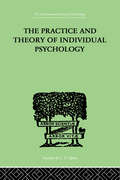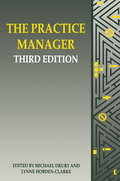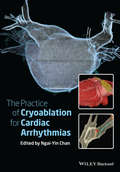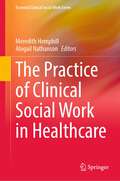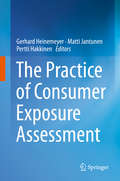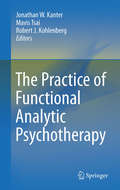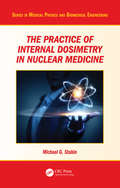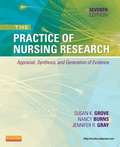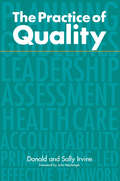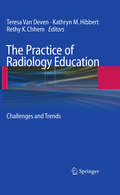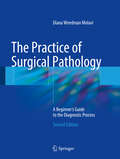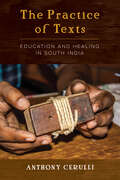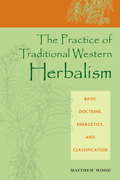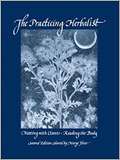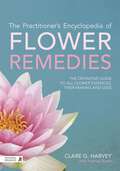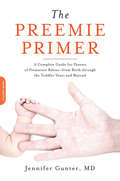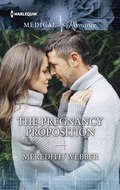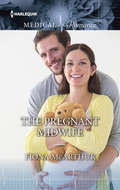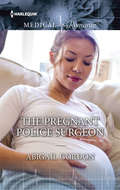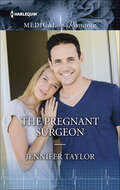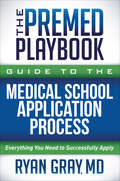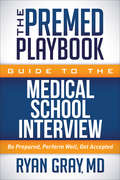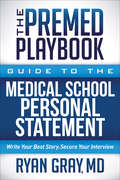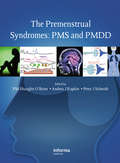- Table View
- List View
The Practice And Theory Of Individual Psychology
by Adler, AlfredFirst Published in 1999. Routledge is an imprint of Taylor & Francis, an informa company.
The Practice Manager
by Michael DruryAs soon as this book first appeared in 1990 it became the standard text for the new generation of practice managers with responsibility for implementing many of the radical changes taking place in general practice. It required reprinting several times to satisfy demand and has since undergone two major revisions to ensure that it is up to date. This Third Edition incorporates several new chapters and new contributors, who reflect efficient and patient-friendly practice, and the continuing evolution of the NHS reforms. Topics are presented in clear, comprehensive and concise terms, from which managers will derive confidence and understanding, whether they use the book for background reading in the practice, or as a textbook on the many training courses that have now adopted it.
The Practice of Catheter Cryoablation for Cardiac Arrhythmias
by Ngai-Yin ChanOffering patients a higher safety profile and less discomfort than radio-frequency ablation, catheter cryoablation is a safe, effective and efficient alternative for clinicians treating atrial fibrillation and other arrhythmias. In The Practice of Catheter Cryoablation for Cardiac Arrhythmias, cardiac electrophysiologists, cardiologists and cardiology fellows will be able to gain an in-depth update in this rapidly advancing field. Those who wish to offer their patients this treatment option will learn how to master various procedural techniques related to catheter cryoablation.Edited by the pioneer of cryoablation therapy in Asia, with chapters written by expert cardiac electrophysiologists from centers in Asia, Europe and the US who have extensive experience using cryoablation to treat patients, this new book: Provides comprehensive, clinically-focused guidance on all applications of catheter cryoablation for the treatment of arrhythmias Focuses on catheter-based techniques that can be performed in the EP laboratory Reflects global best practices form centers with extensive experience in cryoablation techniques Covers the use of catheter cryoablation in both adult and pediatric arrhythmias To further enhance reader's understanding of the emergent techniques covered in the text, the book's companion website features video clips of live cryoablation procedures, plus case-based self-assessment questions for selected chapters.
The Practice of Clinical Social Work in Healthcare (Essential Clinical Social Work Series)
by Meredith Hemphill Abigail NathansonThis book examines the complexities of clinical social work practice in healthcare today. It identifies many of the psychological, social, emotional and spiritual aspects of physical illness in adults. The approach draws on theories from trauma, crisis intervention and supportive counseling, as well as empirical literature from other healthcare fields. Recognizing that social work roles in healthcare range from short-term or crisis-oriented interventions to ongoing, depth-oriented relationships, the authors develop clinical assessment and intervention useful for social workers in various healthcare settings. By utilizing a common frame of clinical analysis, social workers can deepen their critical thinking skills in examining the impacts of specific illnesses and injuries on coping and wellbeing. Each chapter includes an analysis of the psychosocial impacts of the given medical condition across the following spectrums: illness or injury (by onset, course, outcome, and degree of incapacitation) relationship between nature of illness, and emotional and psychosocial functioningcommon clinical issues, and impacts of historical and current trauma end-of-life and bereavementsocial justicethe authors’ reflections on practice The Practice of Clinical Social Work in Healthcare is an essential guide for MSW students and social work professionals in healthcare.
The Practice of Consumer Exposure Assessment
by Gerhard Heinemeyer Matti Jantunen Pertti HakkinenThis book closes a current gap by providing the scientific basis for consumer exposure assessment in the context of regulatory risk assessment. Risk is defined as the likelihood of an event occurring and the severity of its effects. The margin between the dose that leads to toxic effects and the actual dose of a chemical is identified by estimating population exposure. The objective of this book is to provide an introduction into the scientific principles of consumer exposure assessment, and to describe the methods used to estimate doses of chemicals, the statistics applied and computer tools needed. This is presented through the backgrounds of the special fields in exposure analysis, such as exposure via food and by the use of consumer products, toys, clothing and other items. As a general concept, human exposure is also understood to include exposure via the environment and from the work setting. In this context, the specific features of consumer exposure are pointed out and put into the context of regulation, in particular food safety, chemicals safety (REACh) and consumer product safety. The book is structured into three parts: The first part deals with the general concepts of consumer exposure as part of the overall risk analysis framework of risk characterization, risk assessment and risk communication. It describes the three basic features of exposure assessment (i) the exposure scenario (ii) the exposure model and (iii) the exposure parameters, addressing external and internal exposure. Also, the statistical presentation of data to characterize populations, in connection with variability, uncertainty and quality of information and the presentation of exposure evaluation results is described. The second part deals with the specific issues of exposure assessment, exposure via food consumption, exposure from use of consumer products, household products, toys, cosmetic products, textiles, pesticides and others. This part also covers methods for acquisition of data for exposure estimations, including the relevant information from regulations needed to perform an accurate exposure assessment. The third part portrays a prospect for further needs in the development and improvement of consumer exposure assessment, as well as international activities and descriptions of the work of institutions that are involved in exposure assessment on the regulatory and scientific level. And conversely, it creates the rationale for the exposure assessment details necessary to satisfy regulatory needs such as derivation of upper limits and risk management issues.
The Practice of Functional Analytic Psychotherapy
by Jonathan W. Kanter Robert J. Kohlenberg Mavis TsaiSince the earliest years of its development, Functional Analytic Psychotherapy (FAP) has been hailed for its clinical innovation and transformative power with clients across the range of disorders. Building on the foundations of their earlier volumes about this versatile therapy, the editors of The Practice of Functional Analytic Psychotherapy bring together noted clinicians and researchers to explain in depth how FAP can be used in conjunction with a broad spectrum of therapeutic approaches, and with diverse client populations. The hallmarks of the method, including therapist sensitivity and responding to client behavior in the moment, courage, mindfulness, acceptance, and egalitarianism, inform a wide array of interventions and strategies, among them: Integrating FAP with other treatments, including cognitive behavioral therapy, acceptance and commitment therapy, dialectical behavior therapy, behavioral activation, psychodynamic therapies, and feminist therapies. Applying FAP across cultures, nationalities, and ethnicities. Employing FAP with couples. Increasing sensitivity to and effectiveness with sexual minority clients. Modifying FAP for developmentally appropriate use with adolescents. Enhancing a team approach with severely mentally ill patients in institutional settings. Strengthening the power of interpersonal process groups. As a new tool or an enhancement to current practice, these applications of FAP will give therapists an empowering complement to their work. The Practice of Functional Analytic Psychotherapy points to compelling directions in personal growth and change--on both sides of the therapeutic bond.
The Practice of Internal Dosimetry in Nuclear Medicine (Series in Medical Physics and Biomedical Engineering)
by Michael G. StabinWritten by one of the world's leading experts in the field of nuclear medicine dosimetry, this text describes in detail the use of internal dose calculations in the practice of nuclear medicine. While radiation therapy with external sources of radiation always employs calculations of dose to optimize therapy for each patient, this is not routinely conducted in nuclear medicine therapy. As the trend towards an increasing role of dosimetry in therapy planning increases, this book reviews the available methods and technologies available to make this a more common practice. The book begins by covering the mathematical fundamentals of internal dose calculations, and uses sample calculations to demonstrate key principles. The book then moves forward to describe anthropomorphic models, dosimetric models, and types and uses of diagnostic and therapeutic radiopharmaceuticals. The depth of coverage makes it useful reference and guide for researchers performing dose calculations and for physicians considering incorporating dose calculations into the treatment of their cancer patients.
The Practice of Nursing Research: Appraisal, Synthesis, and Generation of Evidence (7th Edition)
by Susan K. Grove Nancy Burns Jennifer R. GrayLearn how to properly evaluate and use existing research data and how to conduct your own original research. This authoritative text gives provides a comprehensive foundation for appraisal, synthesis, and generation of research evidence for clinical nursing practice. This new edition also features enhanced coverage of the research methods most applicable to evidence-based practice (outcomes research, intervention research, and translational research), along with a significant increase in the coverage of qualitative research methodologies. Comprehensive coverage of nursing research organizes content into five units: Introduction to Nursing Research, Nursing Research Processes, Tools for Evidence-Based Healthcare, Strategies for Analyzing Research and Building an Evidence-Based Practice, and Writing Proposals and Obtaining Funding. Rich and frequent examples from the literature demonstrate the importance and immediacy of research in nursing practice and bring principles to life through the context of actual published studies. Strong coverage of quantitative and other clinically-applicable research methodologies gives you a solid grounding to conduct, appraise, and apply research evidence to the realities of clinical practice in today's healthcare environment. NEW! Enhanced emphasis on evidence-based practice equips you to generate research evidence and to appraise and synthesize existing research for application to clinical practice. Using the ANCC Magnet Recognition Program criteria as a point of focus, this book prepares you for today's emphasis on evidence-based practice in the clinical setting. NEW! Expanded emphasis on qualitative research addresses phenomenological research, grounded theory research, ethnographic research, exploratory-descriptive research, and historical research to support the development of nursing. NEW! Updated coverage of digital data collection guides you through use of the internet for research and addresses the unique considerations surrounding digital data collection methods. NEW! Pageburst ebook study guide gives you the opportunity to fully master and apply the text content in a convenient electronic format with integrated interactive review questions.
The Practice of Quality: Changing General Practice (Higher Education Is Facing Fundamental Questions About Financing, Affordability, Access, Quality, Outcomes, And Diversity. College And University Administrators, As Well As State And Federal Policymakers, Need Reliable Data, Effective Interpretation Of Research, Innovative Ideas, And Cogent Analysis To Guide Them In The Critical Decisions They Will Be Facing In The Near And Long Term. The Series B)
by Sally Irvine Donald IrvineThis work adopts a modern approach to quality assurance and quality improvement in general practice. It provides an introduction to the subject, enabling readers to see how best to proceed in their own practices. It revises and updates previous books by Donald and Sally Irvine on clinical audit by placing audit within the wider quality context. It is designed to provide an easily accessible approach to the basic tenets as well as speculating on the future developments in this area, and should be of interest to all members of the practice team. The themes of the book are illustrated by reference to the five major case studies provided, which describe in some detail the various ways of starting, implementing and maintaining quality assurance in general practice today. Practical examples of Total Quality Management, the use of British Standard 5750, Kings Fund organizational audit, Investors in People, and Fellowship of the Royal College of General Practitioners by assessment, are also provided. These studies are written by the practitioners, medical and non-medical, who have themselves been through the experience of turning theory into practice.
The Practice of Radiology Education
by Kathryn M. Hibbert Teresa Van Deven Rethy K. ChhemThe role of medical imaging is increasingly integral to health care, drug discovery, biology, and other life sciences. The changes that are occurring call for innovation in the training of the medical imaging experts of tomorrow. In their previous book, Radiology Education: The Scholarship of Teaching and Learning (2008), the editors addressed the philosophical and theoretical underpinnings of scholarship in radiology education. Now, in The Practice of Radiology Education: Challenges and Trends, they focus on the application of these concepts within educational programs for radiology residents and fellows. The contributors are educators in radiology from around the world, providing a global perspective on the main challenges facing medical imaging education and the potential strategies required to meet these challenges. It is hoped that the book will assist in attaining the ultimate goal of radiology education: to help patients.
The Practice of Surgical Pathology: A Beginner's Guide To The Diagnostic Process
by Diana Weedman MolaviIn pathology education within North America, there exists a wide gap in the pedagogy between medical school and residency. As a result, the pathology intern often comes into residency unprepared. Completely illustrated in color, this book lays the foundation of practical pathology and provides a scaffold on which to build a knowledge base. It includes basic introductory material and progresses through each organ system. Within each chapter, there is a brief review of salient normal histology, a discussion of typical specimen types, a strategic approach to the specimen, and a discussion of how the multitude of different diagnoses relate to each other.
The Practice of Texts: Education and Healing in South India
by Anthony CerulliThe Practice of Texts examines the uses of the Sanskrit medical classics in two educational institutions of India’s classical life science, Ayurveda: the college and the gurukula. In this interdisciplinary study, Anthony Cerulli probes late- and postcolonial reforms in ayurvedic education, the development of the ayurvedic college, and the impacts of the college curriculum on ways that ayurvedic physicians understand and use the Sanskrit classics in their professional work today. His fieldwork in south India illuminates the nature of philology and ritual in the ayurvedic gurukula and showcases how knowledge is exchanged among students, teachers, and patients. The result, Cerulli shows, is that the Sanskrit classics are presented and applied differently in the college and gurukula, producing a variety of relationships with these texts among practitioners. By interrogating the politics surrounding the place of the Sanskrit classics in ayurvedic curricula, this book reveals a spectrum of views about the history and tradition of Ayurveda in modern India.
The Practice of Traditional Western Herbalism: Basic Doctrine, Energetics, and Classification
by Matthew WoodThe Practice of Traditional Western Herbalism places the function of western herbs in their true historical context, apart from homeopathy, traditional Chinese medicine, and Ayurveda. Recently there has been a revival of interest in western herbalism, but practitioners haven't been able to explore its benefits due to a void of information on the topic--the system of medicine the herbs fit into had all but disappeared. To remedy the situation, herbalist Matthew Wood has researched the old-time practices and reconstructed them for modern use. In resuscitating western herbal medicine and bringing it up to date, he gives his readers a powerful tool for holistic theory and treatment. Wood makes the point that plant medicines, because they are made from a broad range of chemical components, are naturally suited for the treatment of general patterns in the body. He argues against the biomedical model of standardization, in which herbs are refined and advertised as if they were drugs suited to an exact disease or condition.
The Practice of Tui Na: Principles, Diagnostics and Working with the Sinew Channels
by Robert AspellTui Na is one of the 'Four Pillars' of Chinese medicine (alongside Acupuncture, herbal medicine and Qi Gong) and is a form of bodywork that includes acupressure, massage techniques, assisted stretching, and joint mobilisations or adjustments that are all based on the key medical principles and diagnostics of the Classics of Chinese medicine. This book is an accessible clinical handbook of Tui Na principles and practice.Tui Na can be used as much more than a musculoskeletal therapy, but in order to use it to its full potential as a medical intervention, it is essential to understand its uses on the Sinew channel system as opposed to the other channel systems commonly used within acupuncture. Tui Na requires an understanding of the principles and pathways of the Sinew channels as a standalone system of the body, as well as its relationship to the other channel and organ systems, and this book provides an accessible introduction to these channels before moving onto Tui Na practice. There are Sections on Diagnosis and Assessment, Techniques and Treatments with hand and joint manipulation techniques covered in detail, along with instruction on developing a Tui Na prescription and protocols for the treatment of common conditions.This book can be used by beginners studying on a hands-on practical course in Tui Na, in addition to qualified Chinese medicine and Tui Na practitioners.
The Practicing Herbalist: Meeting with Clients, Reading the Body
by Margi FlintThe Practicing Herbalist : Meeting with Clients, Reading the Body
The Practitioner's Encyclopedia of Flower Remedies: The Definitive Guide to All Flower Essences, their Making and Uses
by Richard Gerber George Lewith Clare G. HarveyThis comprehensive encyclopedia brings together flower essences gathered from all corners of the globe, from Hawaii and the Himalayas to America and the Australian Bush. It explains what flower remedies are, how they work and how to choose the right remedies for your clients' needs. The properties of 33 families of flower essences and the benefits of over 2,000 remedies, combinations, mists and creams are described. An easy-to-use ailment chart pinpoints remedies for a wide range of physical and psychological conditions, from stress to hormonal imbalance and from allergy to depression. The author provides instructions for prescribing, preparing and using flower remedies alongside illustrative patient case studies. This will be the definitive handbook for practitioners, therapists and students of complementary and alternative therapies working with flower essences and will be valuable reading for those wanting to learn more about how they can use flower essences in their practice.
The Preemie Primer: A Complete Guide for Parents of Premature Babies -- from Birth through the Toddler Years and Beyond
by Jennifer GunterHaving a premature baby-a baby born before the thirty-seventh week of pregnancy- can be a crash course in both medicine and health economics, not just in parenting. Parents face complex information, difficult decisions, and overwhelming grief and worry-with challenges that often extend well beyond those early days and weeks. As an ob/gyn, Dr. Jennifer Gunter has delivered hundreds of premature babies, but as a mother of preemie triplets, she also understands the heartbreak and challenges of prematurity. The Preemie Primeris a comprehensive resource, covering topics from delivery, hospitalization, and preemie development to parenting multiples, handling health issues, and finding special-needs programs. Compassionate, engaging, and medically grounded,The Preemie Primeris the first book on prematurity to combine the insight of a doctor with the experience of a mom.
The Pregnancy Proposition
by Meredith WebberNurse Amelia Peterson's relationship with bad-tempered E.R. doctor "Mac" McDougal has always been rocky. So she's astonished when he asks her out for dinner one night…and even more surprised when she wakes up with him the next morning! The ill-matched pair are both sure it was a one-off — no matter how much they might find themselves desiring each other! But, while Mac doesn't do relationships, he has always wanted a child — and when he realizes that Amelia's pregnant, he comes up with the most unexpected proposal….
The Pregnant Midwife
by Fiona McarthurExpecting the doctor's baby! Courageous midwife Kirsten Wilson has been trying to forget Hunter Morgan since returning to Sydney. Getting up in the helicopter again to rescue tiny babies is just what she needs to put their past behind her. At least until Hunter arrives as the new doctor in charge! Hunter's still attracted to Kirsten, but he can't bring himself to commit to someone so feisty and daring. That is until a huge helicopter crash forces them to put their priorities in order--and the consequences change both their lives forever....
The Pregnant Police Surgeon
by Abigail GordonA father for her child?General practitioner and local police surgeon Dr. Imogen Rossiter is impetuous, fiery, beautiful... and pregnant! When she meets fellow G.P. and police surgeon Dr. Blair Nesbitt, sparks fly between them. Until Imogen tells him she is carrying another man's child.Blair is devastated, yet filled with a desire to protect Imogen and her unborn child--he even proposes marriage! They are both thrown into an emotional turmoil making any relationship between them seem impossible, except fate takes a hand and tests the strength of their love for each other once and for all....
The Pregnant Surgeon
by Jennifer TaylorThe last two things she ever expected—a man and a baby!Sacrificing her personal life to become a high-flying surgeon has left Joanna Martin with few regrets. She has learned not to risk heart for any man—including her new senior registrar, Dylan Archer, even though her secret desire for him is as strong as her drive to succeed…Dylan's determination to impress and break throughhis beautiful boss's cool exterior, both in and out ofthe operating theater, finally results in one nightof passion. But convincing her that theycould have a future together remains achallenge. Then Joanna discoversshe is pregnant…
The Premed Playbook Guide to the Medical School Application Process: Everything You Need to Successfully Apply
by Ryan GrayThe fourth installment of The Premed Playbook series brings together all of the wisdom of helping thousands of students through the medical school application process.
The Premed Playbook Guide to the Medical School Interview: Be Prepared, Perform Well, Get Accepted (The\premed Playbook Ser.)
by Ryan Gray“A must-have for every future doctor’s collection. Great advice, comprehensive, and to the point. Dr. Gray breaks it down, play by play.” —Sujay Kansagra, MD, author of The Medical School ManualThe Premed Playbook Guide to the Medical School Interview is the only book needed to prepare premed students for their medical school interviews. Through interviews with Admissions Committee members and others, Dr. Gray has compiled the most comprehensive book on this subject. Premed students want to know what to expect, but more importantly they need to see examples of what successful applicants have done. The Premed Playbook not only gives them close to six hundred potential interview questions, it also gives them real answers and feedback from interview sessions that Dr. Gray has held with students.“This book touches on every aspect of the interview from applying, during the interview and things to do/not to do after the interview. I highly recommend this book for every student to read and have available for reference during the medical school interview season.” —Antonio J. Webb, MD, orthopedic resident surgeon, motivational speaker, and author of Overcoming the Odds“He challenges the reader to examine their strengths and weaknesses and gives them a blueprint on how to put their best foot forward. His advice is real-world and complied by many interviewers, including myself, who have years of experience interviewing medical school applicants. I highly recommend this book as a fundamental preparation tool for the application process.” —Gregory M. Polites, MD, Associate Professor of Emergency Medicine, Chairman of the Central Subcommittee on Admissions, Washington University School of Medicine
The Premed Playbook: Guide to the Medical School Personal Statement (The\premed Playbook Ser.)
by Dr. Ryan GrayThe Premed Playbook: Guide to the Medical School Personal Statement helps guide students in crafting their stories for the medical school Admission Committees. It's not only a collection of essays from students who got into top schools, but is a showcase of essays that started badly and were honed to tell great stories. Ryan Gray, MD shares the stories of students who likely didn&’t have a shot, but ultimately succeed, in part because of the advice laid out in The Premed Playbook: Guide to the Medical School Personal Statement. They had to fight their way into medical school—and told a great story to do it.
The Premenstrual Syndromes: PMS and PMDD
by Pm Shaughn O’Brien Andrea J Rapkin Peter J SchmidtThis text is definitive, scientific, readable, and offers a reference and text for specialist gynecologists, psychiatrists, and psychologists working at a high level in their respective professions. It is an academic text of the highest level being authoritative and comprehensive.It has the correct balance between the specialties of psychiatry
